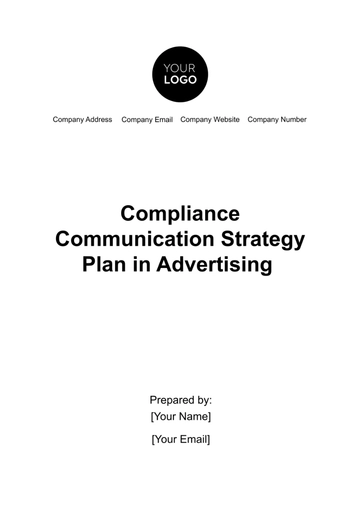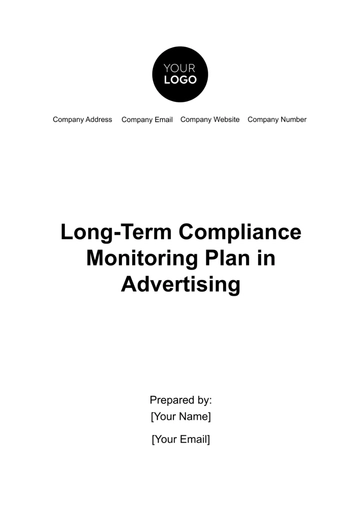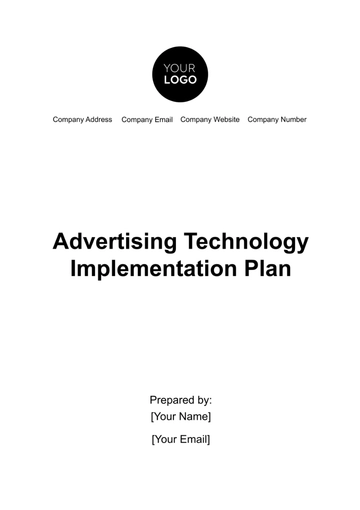Free Brand Lifecycle Management Advertising Plan

I. Introduction And Overview
A. Background
In the ever-evolving landscape of modern commerce, the need for strategic brand management has never been more pronounced. This section sets the stage by delving into the historical context and contextualizing the brand within the broader market dynamics.
B. Purpose Of The Plan
The purpose of this meticulously crafted Brand Lifecycle Management Advertising Plan is to transcend conventional marketing paradigms. It aims to orchestrate a symphony of advertising strategies harmonized with the nuances of each lifecycle stage, steering the brand towards sustained prominence and consumer resonance.
C. Importance Of Brand Lifecycle Management
Recognizing the dynamic trajectory of a brand's journey, this subsection underscores the paramount importance of systematic Brand Lifecycle Management. By navigating through the introduction, growth, maturity, and decline phases with precision, the plan endeavors to fortify the brand's resilience, ensuring it remains agile and relevant amid evolving market trends. The meticulous orchestration of advertising initiatives is poised not merely for brand visibility but as a strategic imperative for cultivating enduring consumer loyalty and market ascendancy.
II. Brand Lifecycle Analysis
In this section, we delve into a meticulous examination of the brand's lifecycle, offering a comprehensive overview that serves as the foundational framework for strategic advertising planning. Understanding the inherent dynamics of the brand's journey is imperative for crafting targeted and effective advertising strategies.
A. Lifecycle Stages
Introduction
At the embryonic stage of the brand lifecycle, we explore the initial foray into the market. This phase involves building awareness, establishing a brand identity, and navigating the challenges of being a newcomer in a competitive landscape.
Growth
As the brand gains traction, the growth stage is characterized by expanding market share and heightened consumer interest. This section meticulously dissects the factors contributing to growth, emphasizing the need for adaptive strategies to capitalize on emerging opportunities.
Maturity
In the maturity stage, the brand reaches a stable position in the market. Our analysis here delves into the intricacies of maintaining relevance, fending off saturation, and leveraging brand equity for sustained consumer loyalty.
Decline
Acknowledging the inevitability of market fluctuations, this segment addresses the decline stage. Understanding the signs of decline equips us with insights to proactively implement measures that can either revitalize the brand or gracefully manage its descent.
B. Milestones, Challenges And Opportunities
To navigate the brand's trajectory successfully, we explore key milestones, challenges, and opportunities at each lifecycle stage. Uncovering these nuances ensures a nuanced and informed approach to advertising planning, promoting agility and resilience in the face of dynamic market conditions.
III. Target Audience And Market Segmentation
A. Definition Of Target Audience
Understanding the target audience is paramount in crafting effective advertising strategies. The target audience is defined based on demographics, psychographics, and behavior, providing a comprehensive profile that guides tailored communication efforts.
B. Market Segmentation Analysis
1. Demographics
Demographic segmentation involves categorizing the audience based on measurable characteristics such as age, gender, income, and location. This analysis ensures that advertising messages resonate with the specific demographic groups most likely to engage with the brand.
2. Psychographics
Psychographic segmentation delves into the audience's lifestyles, values, interests, and attitudes. By understanding the psychological factors influencing consumer behavior, we can create targeted messages that align with the audience's preferences and aspirations.
3. Behavior
Behavioral segmentation considers consumer actions, including purchasing patterns, product usage, and brand loyalty. This analysis allows for the identification of distinct consumer behaviors, enabling the tailoring of advertising strategies to meet the specific needs and preferences of each behavioral segment.
4. Summary
The target audience is meticulously defined by considering both demographic and psychographic factors, ensuring a holistic understanding of the consumers. Demographic segmentation provides quantifiable insights, while psychographic segmentation delves into the deeper motivations and lifestyles of the audience.
Additionally, behavioral segmentation focuses on actions, allowing for a nuanced approach in crafting advertising strategies. The combination of these segmentation analyses forms the foundation for precise and effective communication with diverse consumer groups.
Table: Target Audience And Segmentation Overview
Segment | Characteristics | Key Insights |
Demographic | Age, Gender, Income, Location | Quantifiable data for targeted reach |
Psychographic | Values, Interests, Lifestyles, Attitudes | Deeper understanding of motivations |
Behavioral | Purchasing Patterns, Product Usage | Tailoring strategies to actions |
This table provides a concise snapshot of the target audience segments and their characteristics, facilitating a quick reference for informed decision-making in crafting advertising messages and strategies.
IV. Advertising Objectives
In this section, we outline the overarching objectives guiding the brand's advertising endeavors throughout its lifecycle. These objectives serve as the compass, aligning promotional efforts with the broader strategic goals of the business.
A. Specific Objectives For Each Lifecycle Stage
Tailoring our approach to the unique characteristics of each lifecycle stage, we establish precise objectives to drive focused outcomes:
Introduction Stage Objectives: Propel brand awareness, establish a compelling market presence, and cultivate initial consumer interest.
Growth Stage Objectives: Maximize market penetration, stimulate demand, and fortify the brand's competitive position.
Maturity Stage Objectives: Sustain brand loyalty, optimize profitability, and strategically differentiate the brand in a saturated market.
Decline Stage Objectives: Mitigate potential decline effects, manage product transitions, and explore avenues for brand rejuvenation.
B. Alignment With Business Goals And KPIs
Ensuring synergy with overarching business objectives, these advertising objectives are intricately linked to key performance indicators (KPIs). Through this alignment, we aim to quantifiably measure the impact of advertising initiatives on critical business metrics, fostering a data-driven and results-oriented approach.
V. Advertising Strategies
This section delineates a holistic approach to advertising, tailored to the unique characteristics of each stage in the brand lifecycle. The strategies outlined herein are designed to maximize impact and resonance with the target audience.
A. Customized Strategies For Each Lifecycle Stage
Introduction Stage Strategies
In the introduction stage, focus is on building brand awareness. Utilize captivating storytelling through digital platforms, engaging in teaser campaigns to generate curiosity, and leveraging influencers for initial endorsements.
Growth Stage Strategies
Shift emphasis to market penetration. Employ targeted digital advertising, expand social media presence, and explore partnerships for wider reach. Capitalize on the brand's momentum by emphasizing unique selling propositions.
Maturity Stage Strategies
Maintain brand loyalty and market share. Implement diverse advertising channels, emphasizing product differentiation and customer testimonials. Invest in sustainable campaigns to solidify the brand's position in the market.
B. Decline Stage Strategies
Mitigate decline impact. Consider rebranding efforts, focus on nostalgia marketing, and strategically discount products. Shift advertising towards customer retention, emphasizing the brand's history and value.
C. Channel Selection And Integration
Selecting optimal channels is crucial. Integrate digital platforms, traditional media, and experiential marketing, aligning each with the characteristics of the respective lifecycle stage. Ensure a cohesive multichannel strategy for maximum impact.
VI. Budget Allocation
In this section, we delve into the critical aspect of budget allocation, a strategic endeavor aimed at optimizing financial resources for maximum impact across the various stages of the brand lifecycle.
A. Proportional Budget Allocation To Lifecycle Stages
To ensure a judicious use of resources, the budget allocation is proportionally distributed among the distinct phases of the brand lifecycle. The allocation percentages are meticulously determined based on the significance of each stage and its potential return on investment.
B. Budget Allocation Table
Lifecycle Stage | Allocation Percentage |
Introduction | 20% |
Growth | 35% |
Maturity | 30% |
Decline | 15% |
This table provides a concise overview of the proportional budget distribution, reflecting a nuanced approach that acknowledges the varying needs and opportunities presented by each lifecycle stage.
C. Considerations For Growth Stage
Recognizing the pivotal role of the growth stage in market penetration, a special emphasis is placed on allocating a higher percentage of the budget during this phase. This approach aims to capitalize on the momentum generated during the growth stage, fostering increased brand visibility and market share.
VII. Timeline And Milestones
Efficient management of advertising initiatives requires a well-structured timeline and clear milestones. This section underscores the pivotal role of a thoughtfully planned schedule in achieving strategic objectives.
A. Timeline For Advertising Initiatives
A detailed timeline is provided, outlining the phased implementation of advertising strategies across the brand's lifecycle. This chronological roadmap ensures a seamless flow of activities, allowing for precise execution and resource optimization.
B. Key Milestones For Evaluation
Identifying key milestones is crucial for assessing the effectiveness of advertising efforts. This subsection outlines specific points in the timeline where performance evaluations take place. Milestones serve as checkpoints, facilitating data-driven adjustments and ensuring alignment with overarching business goals.
VIII. Message Consistency And Adaptability
A. Maintaining Message Consistency
Ensure a unified and coherent brand message throughout all advertising endeavors, fostering brand recognition and trust. Emphasize core brand values and propositions consistently across diverse communication channels.
B. Adapting Messaging To Lifecycle Stage Nuances
Tailor messaging strategies to align with the unique characteristics of each lifecycle stage. Acknowledge and address evolving consumer needs, preferences, and market dynamics, optimizing resonance and relevance throughout the brand's evolutionary journey.
IX. Performance Measurement And Analytics
A. Significance Of Performance Metrics
The cornerstone of our Brand Lifecycle Management Advertising Plan lies in the rigorous assessment of advertising initiatives. Our commitment to data-driven decision-making necessitates a thorough understanding of performance metrics to gauge the effectiveness of our strategies.
B. Advanced Implementation Of Analytics Tools
To achieve precision in measurement, we will deploy advanced analytics tools tailored to our unique needs. These tools will meticulously track key performance indicators (KPIs), providing real-time insights into brand awareness, customer engagement, and conversion rates across all lifecycle stages.
C. Iterative Reporting Intervals And Evaluation Criteria
Our reporting framework is designed for agility and adaptability. Iterative reporting intervals will facilitate ongoing evaluation, allowing us to swiftly adjust strategies based on emerging trends and consumer behavior. We've established clear evaluation criteria, ensuring a comprehensive analysis of the data and fostering continuous improvement in our advertising endeavors.
X. Contingency Plans
A. Anticipating Challenges And Risks
In this section, we meticulously identify potential challenges and risks that may arise at various stages of the brand lifecycle. A proactive approach is taken to foresee obstacles that could impede the effectiveness of our advertising strategies.
B. Development Of Contingency Plans
Building on the insights gained from anticipating challenges, this subsection outlines the systematic development of contingency plans. Each potential risk is met with a corresponding strategy, ensuring swift and effective responses to unforeseen circumstances. Contingency plans serve as a safety net, allowing the advertising team to navigate challenges without compromising the overall brand objectives.
C. Adaptive Strategies For Unforeseen Circumstances
Here, the focus is on fostering adaptability. We delve into strategies that enable the seamless adjustment of advertising initiatives when faced with unexpected scenarios. By integrating flexibility into our plans, we ensure that the brand remains resilient, capable of evolving in real-time to maintain a competitive edge.
D. The Contingency Plans section acts as a strategic toolkit, equipping the advertising team with the foresight and agility needed to navigate the dynamic landscape of the brand lifecycle.
- 100% Customizable, free editor
- Access 1 Million+ Templates, photo’s & graphics
- Download or share as a template
- Click and replace photos, graphics, text, backgrounds
- Resize, crop, AI write & more
- Access advanced editor
Introducing Template.net's Brand Lifecycle Management Advertising Plan Template. Crafted for ease, it's editable and customizable to fit your brand's journey seamlessly. Harness the power of our Ai Editor Tool to refine strategies at every stage. Elevate your marketing game with precision and efficiency. Drive success with this essential tool.
You may also like
- Finance Plan
- Construction Plan
- Sales Plan
- Development Plan
- Career Plan
- Budget Plan
- HR Plan
- Education Plan
- Transition Plan
- Work Plan
- Training Plan
- Communication Plan
- Operation Plan
- Health And Safety Plan
- Strategy Plan
- Professional Development Plan
- Advertising Plan
- Risk Management Plan
- Restaurant Plan
- School Plan
- Nursing Home Patient Care Plan
- Nursing Care Plan
- Plan Event
- Startup Plan
- Social Media Plan
- Staffing Plan
- Annual Plan
- Content Plan
- Payment Plan
- Implementation Plan
- Hotel Plan
- Workout Plan
- Accounting Plan
- Campaign Plan
- Essay Plan
- 30 60 90 Day Plan
- Research Plan
- Recruitment Plan
- 90 Day Plan
- Quarterly Plan
- Emergency Plan
- 5 Year Plan
- Gym Plan
- Personal Plan
- IT and Software Plan
- Treatment Plan
- Real Estate Plan
- Law Firm Plan
- Healthcare Plan
- Improvement Plan
- Media Plan
- 5 Year Business Plan
- Learning Plan
- Marketing Campaign Plan
- Travel Agency Plan
- Cleaning Services Plan
- Interior Design Plan
- Performance Plan
- PR Plan
- Birth Plan
- Life Plan
- SEO Plan
- Disaster Recovery Plan
- Continuity Plan
- Launch Plan
- Legal Plan
- Behavior Plan
- Performance Improvement Plan
- Salon Plan
- Security Plan
- Security Management Plan
- Employee Development Plan
- Quality Plan
- Service Improvement Plan
- Growth Plan
- Incident Response Plan
- Basketball Plan
- Emergency Action Plan
- Product Launch Plan
- Spa Plan
- Employee Training Plan
- Data Analysis Plan
- Employee Action Plan
- Territory Plan
- Audit Plan
- Classroom Plan
- Activity Plan
- Parenting Plan
- Care Plan
- Project Execution Plan
- Exercise Plan
- Internship Plan
- Software Development Plan
- Continuous Improvement Plan
- Leave Plan
- 90 Day Sales Plan
- Advertising Agency Plan
- Employee Transition Plan
- Smart Action Plan
- Workplace Safety Plan
- Behavior Change Plan
- Contingency Plan
- Continuity of Operations Plan
- Health Plan
- Quality Control Plan
- Self Plan
- Sports Development Plan
- Change Management Plan
- Ecommerce Plan
- Personal Financial Plan
- Process Improvement Plan
- 30-60-90 Day Sales Plan
- Crisis Management Plan
- Engagement Plan
- Execution Plan
- Pandemic Plan
- Quality Assurance Plan
- Service Continuity Plan
- Agile Project Plan
- Fundraising Plan
- Job Transition Plan
- Asset Maintenance Plan
- Maintenance Plan
- Software Test Plan
- Staff Training and Development Plan
- 3 Year Plan
- Brand Activation Plan
- Release Plan
- Resource Plan
- Risk Mitigation Plan
- Teacher Plan
- 30 60 90 Day Plan for New Manager
- Food Safety Plan
- Food Truck Plan
- Hiring Plan
- Quality Management Plan
- Wellness Plan
- Behavior Intervention Plan
- Bonus Plan
- Investment Plan
- Maternity Leave Plan
- Pandemic Response Plan
- Succession Planning
- Coaching Plan
- Configuration Management Plan
- Remote Work Plan
- Self Care Plan
- Teaching Plan
- 100-Day Plan
- HACCP Plan
- Student Plan
- Sustainability Plan
- 30 60 90 Day Plan for Interview
- Access Plan
- Site Specific Safety Plan





























